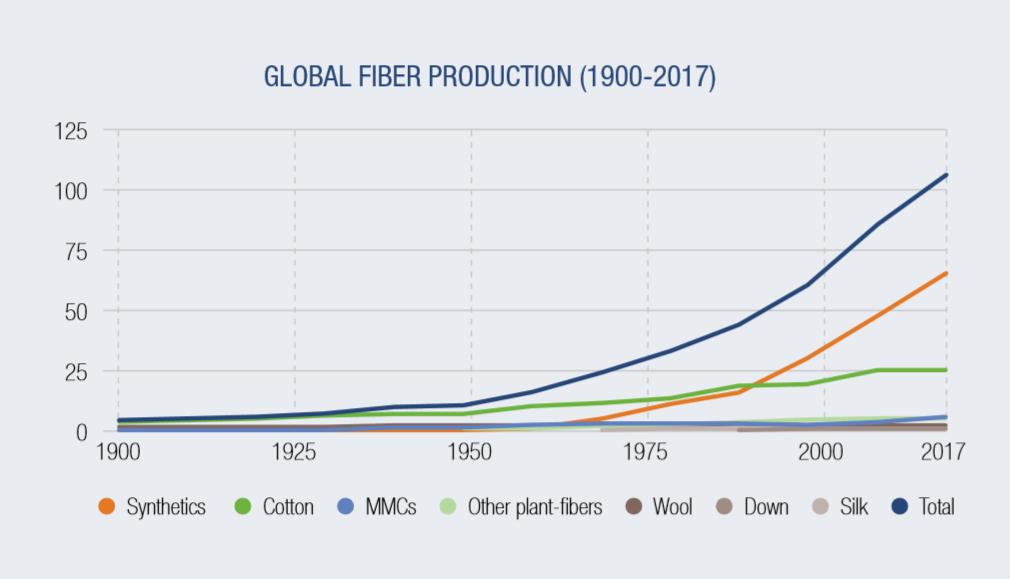It is the bulk production of materials for the fashion industry today that causes the heavy environmental burden, and it is these materials for which it is necessary to find substitutes.
Man Made Fiber (MMF) production continues to rise yet again and has been doing so without pausing for many years. Due to growing demand and consumer consciousness, MMF is expected to peak production volume and play a major role in the global fashion market through contribution to the Green Movement in Fashion.
According to Grand View Research, the entire fiber market was valued around USD 25 billion last year and it is expected to reach USD 44.2 billion by 2030. According to the same report, MMF is rapidly gaining market share and stood at 62% in 2015.
Textile Exchange also shared a similar view where man-made fiber accounts for almost 70% of the global market share. Both the sources confirmed an 8% market growth which strongly indicates that man-made fiber will soon overtake the entire fashion industry.
Man-made fiber was a great breakthrough in textile technology which continues to take over the entire fashion industry. Joseph Swan was the man behind the innovation of synthetic fibers in early 1880s. Swan was working to make carbon filament for light bulb and later realized that this could revolutionize the textile industry. Soon after the development, Swan unveiled his groundbreaking textile fiber in International Innovations Exhibition of London in 1885.
The first artificial silk was invented by French industrialist and engineer Hilaire de Chardonnet and he presented the invention in Paris Exhibition in 1889.
A half century later, polyester fiber was invented by John Rex Whinfield and now it is the most used textile fiber in the world holding 53% global market share.
Man Made fiber has come along a long way and accounts for more than 70% of total fiber production. In 1900, synthetic or Man-Made fabric was not well accepted. During the late 1970s however, MMF started to rise and exceeded the supremacy of cotton fiber in 1990. While cotton fiber production remains flat, synthetics continue to see steep increments. In 2017, total global fiber production stood at 105 million metric tons. Man-made fiber accounted for 71.1 million metric tons. Only polyester fiber covered 51% of total fiber production. (source)

Rapid growth of world population in the last few decades have boosted the consumption of fiber more than ever. According to a United Nations report, currently global population is 7.7 billion and it will hit 9.7 billion by 2050. (source)
Along with the growth of the population, demand for fiber is also increasing in rapid scale. And the rise in purchase power further boosts fashion consumption.
Man-made fiber is a decent solution for a greener Earth. For centuries, the clothing industry has caused damage to the environment and continues to do so rapidly. Measures need to be taken in order to relieve the future generation of the burden. Because people are becoming conscious about environmental disasters, preservation of natural resources is inevitable.
The entire world is under threat of non-biodegradable plastics and people are taking measures by recycling. A large portion of recycled plastics are made into fashion products. This in turn, reduces further waste caused by plastics and as a result; man-made fiber should capture more market share in the near future.
Processing natural fiber consumes significant amounts of water and energy which causes carbon emission at an industrial scale. On the contrary, man-made fibers fight back by reducing environmental waste.
China remains the largest exporter of man-made fiber followed by South Korea, USA, and Germany. In 2017, China alone exported USD 924 million worth of synthetic fabrics.
Vietnam, China, and Germany are the largest importers of artificial fabrics. Vietnam imported USD 200 million worth of fabrics in 2017. (source)
Though Bangladesh is not among the largest man-made fiber importers yet according to BTMA, Bangladesh imported 1,12,388 tons of man-made fiber in 2016 and is expected to grow significantly in coming years. The man-made fiber import is growing fast in Bangladesh because demand from international brands is increasing aggressively.
In conclusion, man-made fiber has been on the rise since the early 1990s and presently holds 71% market share. Polyester being the most used and produced fiber in the world with 51% market share. According to the market growth of man-made fiber, it may entirely take over the fashion industry and is a crucial step towards a green world.